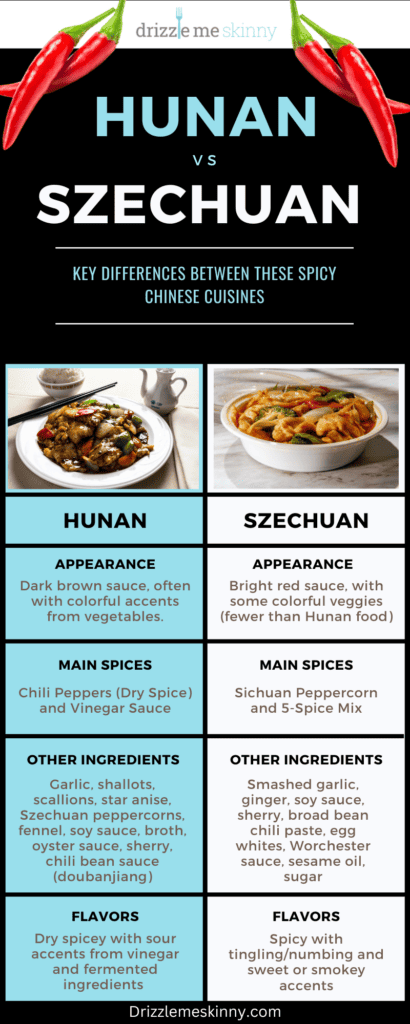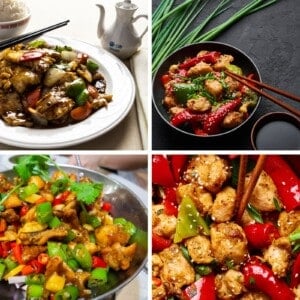If you’ve ever eaten at a Chinese restaurant, you will have seen Hunan and Szechuan dishes on the menu. (Usually chicken or beef.) You may know that of the 8 major schools of Chinese cooking, Hunan and Szechuan are known to be the spiciest.
While both cuisines pack the heat, their flavors are quite distinct thanks to their ingredients. Their flavor isn’t the only difference, though. We compare these fiery foods so you can decide what to order your next time out—or use our suggested recipes to whip up a healthier version at home!
What is Hunan style food?
Hunan is a region in southeastern China known for its spicy, dry-heat style of cooking. Hunan cuisine is divided into 3 distinct styles from major regions in the area: Xiang River region, Dongting Lake region, and Western Hunan region.
Hunan food is known for its hot, sour, and salty flavor combo. The heavy use of a dry chili pepper mix, vinegar, shallots, and garlic gives this cuisine a depth of flavor and heat that is unmatched in other Chinese styles of cooking.
Origins of Hunan
Hunan cooking has been evolving for over 2,000 years, adapting with the introduction of new ingredients through trade. Hunan dishes feature more vegetables than Szechuan food, thanks to the region’s strong agriculture and variety of resources. The province has a subtropical climate with hot, humid summers and cool, damp winters.
The Hunan menu changes with the seasons, utilizing the vegetables and other ingredients that are available at that time. Cold dishes, such as cold meats with chilis, are more popular in the summer. In the winter, hot pots and stir fries help to warm the body. There is always some spice.
Hunan food is rising in popularity, both in China and beyond. That being said, it hasn’t yet reached the star status that Szechuan and other styles of food have. But there are many (over 4,000!) Hunan dishes to be enjoyed.
What does Hunan food taste like?
As with Szechuan cuisine, Hunan food is known for its spice. The spiciness in Hunan cooking is described as 香辣 (gānlà) or “dry spicy”. The chili in Hunan dishes is pure and delivered without carrier oil.
The spice is complemented by a distinct sourness and saltiness, and there’s even a smokiness to some dishes.
Hunan food is most commonly sauteed, stir-fried, steamed, or smoked. Braising is also popular in Hunan. Many Hunan dishes contain a vinegar-based sauce, which provides a cooling sensation and brings out the complexity of other spices used.
What are the main ingredients used in Hunan cooking?
With such a variety of dishes (over 4,000 by some accounts), there are endless combinations of ingredients used in Hunan cooking. The main staple ingredients of the Hunan style are:
- Spices: Dried, fresh, and/or pickled peppers; garlic; shallots, scallions, star anise, Szechuan peppercorns, and fennel.
- Sauce: Vinegar, soy sauce, oyster sauce, sherry, chili bean paste (doubanjiang), chicken broth, sugar, cornstarch
- Vegetables: Crunchy vegetables, such as carrots, broccoli, snow peas, green beans, and eggplant.
- Meats: Fish, chicken, duck, frog’s legs, turtle, and preserved meats such as beef, pork, and lamb. Pork is preferred regionally, while chicken and beef are the most popular outside of China.
- Served with: Rice or rice noodles
What is the most famous Hunan dish?
In the Hunan region, the dish of choice will change with the seasons: cool dishes in the summer and hot dishes in the winter, each incorporating vegetables and proteins in season.
In the west, though, Hunan chicken is the most popular, with Hunan beef a close second. These are commonly found on Chinese restaurant menus in North America and Europe.
Other popular Hunan dishes include steamed fish with chopped chili peppers, steamed preserved meats, fried pork with chili, Hunan rice noodles, and spicy salted duck. Head to Travel China Guide for a list of 10 popular Hunan dishes to try, including flavor descriptions, cooking methods, and photos.
Best Hunan recipes
We understand that frog legs and steamed fish heads aren’t for everyone, so we’ve pulled some of the best recipes for more popular dishes in the West.
For a spicy and savory Hunan chicken recipe, turn to Dinner at the Zoo! Crunchy and colorful veggies pair with a saucy breaded chicken in this healthier-at-home recipe that comes together in just a half hour!
The Woks of Life comes through again with this authentic Hunan beef recipe. The beef is marinated and pan-fried until it’s crispy and married with crunchy peppers, aromatics, and a sweet and tangy sauce that will have your mouth watering.
This Hunan pork stir-fry from Red House Spice is garlicky and spicy. It gets an extra hit of flavor thanks to the addition of fermented black beans, two types of chili, garlic, and soy sauce.
What is Szechuan style food?
Szechuan cuisine (also called Sichuan or Chuan Cai) is one of the most popular of the eight major schools of Chinese cooking and is the most widely served cuisine in China. Like Hunan food, Szechuan is known for its spice and use of hot peppers.
This food comes from the Sichuan province of southwest China. Aside from its notable heat, Szechuan is known for its numbing quality, known as “mala” or “numbing hot.” The 麻” (má) or numbing comes from Sichuan peppercorns and “辣” (là) or spicy flavor comes from the use of chili peppers.
Origins of Szechuan-style food
Szechuan cooking wasn’t also known for its spice. The cuisine has evolved over time as the people of the Sichuan region began using ingredients from around the world. Near the end of the 17th century, the hot pepper now known as Sichuan peppercorn made its way over from South America.
The local people took to this spice as a way to combat the heat and humidity in Sichuan province. Soon all of their dishes were heavily spiced, giving birth to the Sizuan flavor that has grown to be a worldwide favorite.
Szechuan cuisine has been growing in popularity for some 800 years, since the Southern Song Dynasty. Today, the capital of the Sichuan Province (Chengdu) is known as a culinary hub of the world, being named a city of gastronomy by UNESCO in 2011.
What do Szechuan dishes taste like?
The primary flavor of Szechuan cooking is spicy, thanks to its main ingredient: Sichuan peppercorn. The Sichuan pepper is not only hot but creates a tingling or numbing sensation on the tongue.
Along with the peppercorn, chili, ginger, black pepper, mashed garlic, and shallots bring an aromatic depth of flavor to this cuisine. Other flavors of Szechuan dishes include sweet and sour with citrusy undertones.
Sichuan dishes are commonly stir-fried, braised, baked, or steamed. Stewing is also popular in this region.
What are the main ingredients used in Szechuan cooking?
Sichuan peppercorns, often delivered in a carrier vegetable oil, is the primary ingredient that makes Szechuan food tick. Here are some of the main ingredients used in this cuisine:
- Spices: Szechuan peppercorns, smashed garlic, ginger, and a five-spice mix comprised of fennel seed, star anise, cinnamon, clove, and Sichuan pepper.
- Sauce: Soy sauce, sherry, broad bean chili paste, Worchester sauce, egg whites, sesame oil, sugar
- Vegetables: Some vegetables, such as carrots, red bell peppers, green onion, mushrooms, bean sprouts, and fresh chilis.
- Meats: Pork, beef, chicken, fish
- Served with: Rice or rice noodles
What is the most famous Szechuan dish?
Szechuan dishes vary greatly, but arguably the most popular dishes on Chinese menus are Kung Pao chicken, Szechuan beef, and Szechuan chicken. Some other notable dishes include hot pot, mapu tofu, dan dan noodles, steamed pork, boiled fish, and sesame chicken.
Head over to Serious Eats for mouthwatering descriptions of 14 Sichuan dishes you can try next time you go out!
Best Szechuan recipes
We rounded up some of the top Szechuan-style recipes for you to try!
If Kung Pao Chicken is your go-to, you’ll want to give this recipe from China Sichuan Food a try! Tender chicken and crispy peanuts marinate in a sweet, sour, and spicy sauce that will have you coming back for more.
Carlsbad Cravings brings the heat with this Sichuan Beef stir fry recipe. Tender beef in a dynamic spicy sauce with layers of flavor from chiles, garlic, ginger, and Szechuan peppercorns. Yum!
If you want to add some veggies to your spread, be sure to check out our Drizzle Me Skinny Chinese-style air fryer green beans! The air frier keeps these healthier than deep-frying while delivering crispy beans in tangy, spicy, and savory seasonings.

Summary: What is the difference between Hunan and Szechuan food?
Both cuisines are known for their spiciness, a response of the local people to hot and human conditions in the Sichuan and Hunan Provinces of China. However, there are many important differences when comparing Szechuan vs Hunan foods:
- Origins: Hunan cuisine comes from the Xiang River, Dongting Lake, and the western Hunan province of China. Szechuan cuisine comes from the southwestern regions of China known as Sichuan or Szechuan Province.
- Appearance: Hunan food has a dark brown sauce, while Szechuan sauce is much redder in appearance.
- Main Spice: Szechuan food uses the Sichuan peppercorn, which creates a tingling or mouth-numbing sensation. Hunan uses a dry mix of various chilis.
- Other Ingredients: Hunan uses garlic, shallots, scallions, star anise, Szechuan peppercorns, fennel, soy sauce, oyster sauce, dry sherry, broth, and chili bean sauce (doubanjiang). Szechuan uses smashed garlic, ginger, soy sauce, sherry, broad bean chili paste, Worchester sauce, sesame oil, and brown sugar.
- Overall Flavor: Hunan dishes have a sour component thanks to vinegar and fermented ingredients. Szechuan dishes may be sour, sweet, or smokey.
Is Hunan or Szechuan better?
If you prefer a more intense and straightforward spiciness, the chili-driven Hunan dishes are for you. Szechuan peppercorn does have some spice, but it’s milder and has the unique component of its numbing and tingling effects.
Another distinguishing factor is the complimentary flavors. If you like a bit of tanginess, go for Hunan. Its vinegar-heavy sauces give a sourness that compliments the intense heat nicely. If you prefer a bit of sweetness and smokiness, Szechuan is your best bet.
Related Recipes
If we have you craving Asian food, check out these 25 Asian Pork Recipes before you go ordering out! From BBQ spare ribs and grilled pork belly to pork binagoongan and Japanese Tonkatsu, this list has recipes from all across Asia to get your juices flowing.
If noodles are more your thing, read up on Chow Fun vs Mei Fun for a FUN introduction to two popular Chinese dishes. But if you’re leaning toward Thai food, our Pad See Ew vs Pad Thai post will help you decide!
And don’t forget about dumplings! We tell you ALL you want to know about these delicious pockets of yum in this Wonton vs Dumpling article. As always, recipes are included!
Frequently Asked Questions (FAQs)
Q1: Is Hunan hotter than Szechuan?
A: While both types of cuisine are known for their spice, the chilis used in Hunan dishes are generally spicier than the Sichuan peppercorns used in Szechuan cooking.
Q2: Is Hunan healthier than Szechuan?
A: This depends greatly on the dish and cooking methods used. Both cuisines are high in salt, fats, and calories when eating out. Hunan food tends to have more veggies.
Q3: How is Szechuan Chinese food different?
A: The Szechuan peppercorns used to spice this cuisine offer a unique tingling and numbing quality. It’s much more flavorful than other Chinese styles of cooking.
Q4: What is the difference between Sichuan and Szechuan?
A: These are two spellings of the same word, and both are correct. Sichuan is more prevalent on the west coast of China, while Szechuan is used in the east.
Hunan vs Szechuan

Ingredients
Instructions
- Select your favorite recipe
- Click the link to view the recipe instructions
- Follow linked instructions
- Enjoy!

